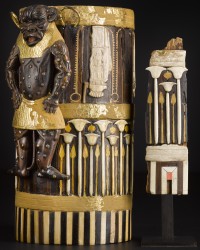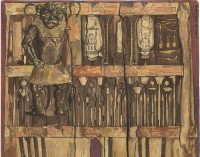 Recently identified fragments from an elaborately decorated wooden box inscribed with the cartouche of 18th Dynasty Pharaoh Amenhotep II have revealed new information about the original design of the box. The fragments were held by London antiques dealers Charles Ede. Egyptologist Tom Hardwick researched them and discovered their connection to the box in the National Museums Scotland. He alerted the gallery and the gallery alerted the museum. Thanks to financial support from the Art Fund and the National Museums Scotland Charitable Trust, the museum acquired the fragments for £25,000. The reunited box and fragments will go on display at the National Museums Scotland where they will be part of the exhibition The Tomb: Ancient Egyptian Burial which runs from March 31st through September 3rd, 2017.
Recently identified fragments from an elaborately decorated wooden box inscribed with the cartouche of 18th Dynasty Pharaoh Amenhotep II have revealed new information about the original design of the box. The fragments were held by London antiques dealers Charles Ede. Egyptologist Tom Hardwick researched them and discovered their connection to the box in the National Museums Scotland. He alerted the gallery and the gallery alerted the museum. Thanks to financial support from the Art Fund and the National Museums Scotland Charitable Trust, the museum acquired the fragments for £25,000. The reunited box and fragments will go on display at the National Museums Scotland where they will be part of the exhibition The Tomb: Ancient Egyptian Burial which runs from March 31st through September 3rd, 2017.
Made from Lebanese cedar wood, the cylindrical box was made around 1427-1400 B.C. with the finest of raw materials and craftsmanship. It is inlaid with ebony strips and ivory plaques with copper alloy and faience accents. Some of the gilding on the central figure of the god Bes and on three bands encircling the cylinder has survived. Ivory cartouches on the top half of the box contain the throne name of Amenhotep II. Underneath the cartouches are the Egyptian hieroglyph for “gold,” a symbol of the divine and eternal life. Notched ribs from palm tree branches, symbolizing the passage of a year and therefore the portent of a long reign, stand on either side of the cartouches. The cartouches and royal symbols festooned around Bes, fierce protector of hearth and home, suggests the box invoked the protection of a very personal, homebody god to ensure a long reign and life for Amenhotep.
The box has been in the collection of the National Museums Scotland for 160 years, but its origins are nebulous. The first time the box appears in the museum records is in the 1890s when it was first reassembled from fragments by archaeologist and museum director Joseph Anderson. According to an article written in 1895 by renown Egyptologist Sir Flinders Petrie, Anderson found the fragments in a box of odds and ends from the Rhind Collection.
 Alexander Henry Rhind was a Scottish archaeologists who excavated Egypt in the mid-19th century and who pioneered detailed archaeological documentation. He brought back hundreds of artifacts now in the collection of the National Museums Scotland, including the full contents of a tomb he’d excavated in Thebes which was built in 1290 B.C. for the Chief of Police, looted repeatedly and reused for more than a 1000 years. When Rhind discovered the tomb, its last occupation from the Roman Egyptian era was undisturbed. Until he took it all to Scotland, of course. This is the tomb that is the focus of the National Museums Scotland’s upcoming exhibition.
Alexander Henry Rhind was a Scottish archaeologists who excavated Egypt in the mid-19th century and who pioneered detailed archaeological documentation. He brought back hundreds of artifacts now in the collection of the National Museums Scotland, including the full contents of a tomb he’d excavated in Thebes which was built in 1290 B.C. for the Chief of Police, looted repeatedly and reused for more than a 1000 years. When Rhind discovered the tomb, its last occupation from the Roman Egyptian era was undisturbed. Until he took it all to Scotland, of course. This is the tomb that is the focus of the National Museums Scotland’s upcoming exhibition.
Unfortunately, Rhind’s archaeological recording skills did not extend to documenting the discovery of the box fragments, and since he died in 1863 when he was just 29 years old he was no longer around to answer any questions by the time Joseph Anderson stumbled on the pieces. Museum curator and expert in Egyptian art Cyril Aldred studied the box in the 1940s.  He made a detailed line drawing and watercolor of it in 1946 and proposed that Rhind had discovered the box in a tomb next to the recycled Roman Egyptian tomb. This tomb held the mummies of Amenhotep II’s granddaughters, among other princesses. They would have had good reason to have an extra fancy box dedicated to the grandpa, and since this was not the mummies’ original resting place but rather a second, less visible location used by priests to spare the royal remains from looting, the box’s fragmentary condition could be explained by the move.
He made a detailed line drawing and watercolor of it in 1946 and proposed that Rhind had discovered the box in a tomb next to the recycled Roman Egyptian tomb. This tomb held the mummies of Amenhotep II’s granddaughters, among other princesses. They would have had good reason to have an extra fancy box dedicated to the grandpa, and since this was not the mummies’ original resting place but rather a second, less visible location used by priests to spare the royal remains from looting, the box’s fragmentary condition could be explained by the move.
The box was restored again in 1950s, and while it was less terrible than the 19th century attempt (the back is missing, but they still curved into a cylinder even though it was too skinny and the ends didn’t meet or match), conservators had to fill in blanks without references to what it might have looked like when whole. The newly surfaced fragments answer some of those questions and confirm that the last restoration was not accurate.
The decoration on one of the fragments features a motif representing the façade of the royal palace, tying in with the rich royal symbolism on the box, and confirming the object’s royal association. Furthermore, where the decoration of the box differs from that of the fragments, it reveals that the part of the box was incorrectly restored in mid-20th century.
The box is a much more elaborate version of the types of wooden containers often found in ancient Egyptian tombs, other examples of which are in National Museums Scotland’s collections. It was probably used in the royal palace to hold cosmetics or expensive perfumes and likely belonged to a member of the king’s family, most probably one of his granddaughters.
Even with its missing bits and questionable past restorations, the box is widely considered a masterpiece of ancient Egyptian decorative woodwork. Petrie described it as “a very interesting example of the fine work of that most wealthy and luxurious period, the 18th Dynasty.” After their stint on display in the new exhibition, the box and fragments will be kept in storage while the museums constructs a new Ancient Egypt gallery to house it. The new gallery is scheduled to be completed in 2018-2019.
People in modern times tend to underestimate the importance of adequate skin care. Honestly, what kind of so-called ‘civilization’ mummifies the dead without their beauty cases ? 😎
No word about Anck-Su-Namun? Or do we not talk about she who shouldn’t have been named?